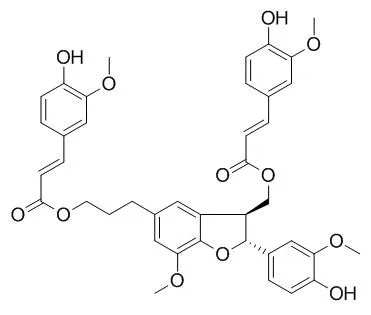| In vitro: |
| Chem Pharm Bull (Tokyo). 2011;59(11):1396-9. | | Chemical constituents from Sambucus adnata and their protein-tyrosine phosphatase 1B inhibitory activities.[Pubmed: 22041077] |
METHODS AND RESULTS:
The MeOH extract from the whole plants of Sambucus adnata has shown significant protein-tyrosine phosphatase 1B (PTP1B) inhibitory activity. Chemical study on the extract resulted in the isolation of thirteen compounds, including a novel triterpene (1). The structure of 1 was determined to be 1α,3β-dihydroxy-urs-12-en-11-one-3-yl palmitate on the basis of extensive spectroscopic analyses.
CONCLUSIONS:
Among the isolated compounds, ursolic acid, oleanolic acid and (±)-Boehmenan showed the most potent PTP1B inhibitory activity in vitro with the IC(50) values of 4.1, 14.4 and 43.5 µm, respectively. The kinetic analysis indicated that (±)-Boehmenan inhibits PTP1B activity in a competitive manner. | | Phytomedicine. 2016 May 15;23(5):468-76. | | Boehmenan, a lignan from the Chinese medicinal plant Clematis armandii, induces apoptosis in lung cancer cells through modulation of EGF-dependent pathways.[Pubmed: 27064005 ] | Epidermal growth factor receptor (EGFR) is an effective molecular target for cancer treatment. Boehmenan, a lignan from the dried stems of Clematis armandii, exhibited the potent cytotoxic effects against many cancer cell lines in previous studies. However, the effects and underlying mechanism of Boehmenan on non-small cell lung cancer (NSCLC) remains unclear. The present study was designed to determine the in vitro anti-cancer properties and underlying molecular mechanisms of Boehmenan on A549 NSCLC cells.
METHODS AND RESULTS:
Cellular viability and chemoattractive properties of macrophages were investigated by using MTT and transwell migration assay, respectively. Mitochondrial membrane potential (ΔΨm), apoptotic ratio, and cell cycle were measured by flow cytometry. Protein expression was visualized by Western blot using specific antibodies. Boehmenan concentration-dependently suppressed proliferation and induced G1 phase arrest in A549 NSCLC cells, which were accompanied by reduction of migration, colony formation and increase of apoptosis in A549 cells. In addition, Boehmenan treatment markedly modulated apoptosis-related protein (p53, p21, cleaved caspase 3, and cleaved PARP) and cyclin D1 expression and induced ΔΨm collapse in a concentration dependent manner. Furthermore, Boehmenan concentration-dependently inhibited EGF-induced activation of EGFR and its downstream signaling molecules, including MEK, Akt, ERK1/2, and STAT3.
CONCLUSIONS:
Taken together, our results suggested that Boehmenan-mediated anti-tumor property was mediated by modulation of mitochondria and EGFR signaling pathway in A549 NSCLC cells. |
|






 Cell. 2018 Jan 11;172(1-2):249-261.e12. doi: 10.1016/j.cell.2017.12.019.IF=36.216(2019)
Cell. 2018 Jan 11;172(1-2):249-261.e12. doi: 10.1016/j.cell.2017.12.019.IF=36.216(2019) Cell Metab. 2020 Mar 3;31(3):534-548.e5. doi: 10.1016/j.cmet.2020.01.002.IF=22.415(2019)
Cell Metab. 2020 Mar 3;31(3):534-548.e5. doi: 10.1016/j.cmet.2020.01.002.IF=22.415(2019) Mol Cell. 2017 Nov 16;68(4):673-685.e6. doi: 10.1016/j.molcel.2017.10.022.IF=14.548(2019)
Mol Cell. 2017 Nov 16;68(4):673-685.e6. doi: 10.1016/j.molcel.2017.10.022.IF=14.548(2019)